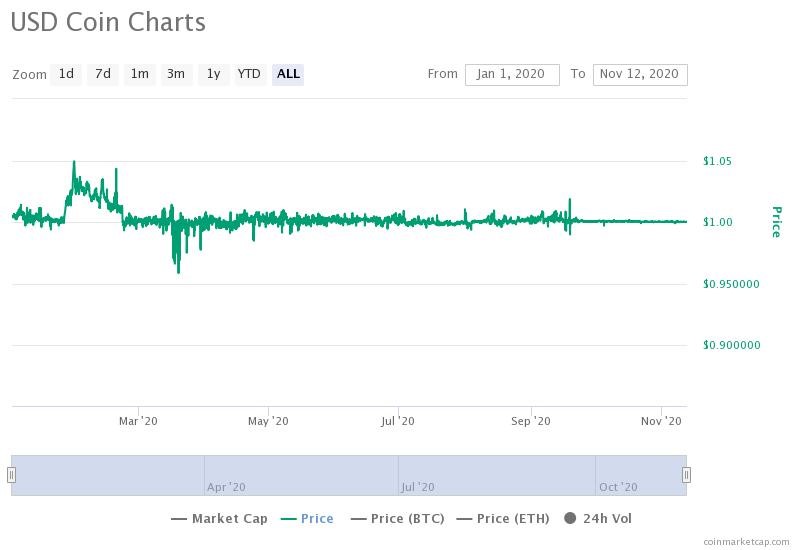Do you remember when a basic savings account actually generated a bit of coin?
I just checked: The last time we could earn anything north of 5%—the threshold most savers used to consider “solid income”—was the summer of 2007. Crazy to think that was more than 13 years ago. In those intervening years, we’ve become so accustomed to earning basically nothing on our idle cash that we either forsake the effort as tilting at financial windmills, or we dive into the stock market in search of some kind of return (which helps explain why Wall Street these days is about as rational as a psych ward).
So, would it surprise you that I opened an app on my iPhone at the start of November to see that I’d received my regular, monthly interest payment equating to an 8.6% annual yield on my dollars?
No joke. No meaningful risk.
I’m earning that yield on what’s known as USD Coin—USDC—a cryptocurrency built to shadow the U.S. dollar. By which I mean, this is no typical crypto, such a bitcoin or Ethereum, where volatility can add or subtract 10% or 20% in a matter of hours, if not minutes. USDC is what’s known as a “stablecoin,” a coin that’s pegged to a stable, underlying asset such as the dollar, the yen, the euro, the British pound, and a few other real-world, fiat currencies.
As a society, we are rapidly approaching the e-Rubicon, that point of no return after which the monetary world will function entirely electronically. China is currently in the midst of a large-scale, real-world test of a digital yuan. The European Union is rapidly moving toward a digital euro. And our own Federal Reserve is actively working on a digital dollar that ultimately will replace the physical dollars in our wallet. How all of that ultimately plays out—and when—is a guess at this point. Still, the fact remains this is the world rapidly racing toward us. We are watching a fait accompli as it occurs in real time.
As such, I see stablecoins as the bridge from here to there, connecting old money to new and allowing forward-thinkers to gain a leg up in understanding and working with crypto. And what better way to learn than to get paid for participating in this new world order?
To be clear, just because stablecoins are a form of cryptocurrency doesn’t mean they’re risky and volatile. At their most basic, they’re designed for price stability, almost like a money-market mutual fund is designed to always be worth $1. Stablecoins tend to do a pretty good job of that. Here’s a look at USDC so far this year:

For the vast majority of time, the coin fluctuates along either side of $1, barely pushing $0.99 or $1.01. On occasion, you’ll get a blip a bit higher, or a bit lower (usually tied to an event when demand for stablecoin rapidly changes for whatever reason). But those moves are self-correcting because of the mechanisms in place to ensure that stablecoins track their underlying doppelgänger. As such, I feel comfortable holding stablecoins as a stand-in for some of my cash because I know the price doesn’t really go anywhere—precisely the role these coins were designed to play.
The only reason I say “a stand in for some of my cash” is because this is crypto, there’s still a time element involved in converting coins back into fiat dollars, and moving those dollars from a crypto exchange to my bank—much like selling a stock and moving the cash from your brokerage account to your bank account. I want immediate access to some cash for emergencies and whatnot, without having to muck about with a transfer process.
But beyond that, I’m quite content with stablecoins and collecting the outsized yields.
Speaking of outsized yields, you might be wondering, “Why can stablecoins pay so much?”
Well, it’s because you’re earning part of the return for the lending activity that’s going on beneath the surface. In my case, I’ve put some of my cash with a company called BlockFi (this is not an endorsement; I’m just offering a real example so you can understand the process). BlockFi takes the crypto that I and others have deposited and it lends money to borrowers who want to purchase a house, buy a car, pay off bills, invest in the stock or crypto markets, or whatever. Those borrowers put up crypto-based collateral, and they pay an interest rate. In turn, BlockFi pays me a rate of return. (Not only are the loans backed by crypto, but there are various safeguards in place including loan-to-value minimums that protect BlockFi and the savers.)
Again, it’s all very similar to banking: deposit cash in a savings account or a certificate of deposit, which the bank then lends to borrowers, and, in return, pays the savers an interest rate (or, rather, used to pay us an interest rate).
The one caveat I will mention, just so that you’re aware, is that when you start looking at stablecoins denominated in other currencies—EURS (euro), trueGBP (pound), QCAD (Canadian dollar), etc.—you will see much more fluctuation, as well as prices that are well above or below $1. That’s because the underlying currencies are bouncing around relative to the U.S. dollar. So, while they maintain their 1:1 peg in the local currency, they do move up and down depending on U.S. dollar strength or weakness on the global stage.
But if you live overseas like me, and you work and play in a foreign currency, then non-dollar stablecoins might make sense.
Either way, this is where our world is going. Owning stablecoins will acclimate you to the cryptocurrency process…and it can be a nice way to earn a decent interest rate, with largely miniscule volatility, while you wait for the digital dollar to emerge.

